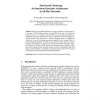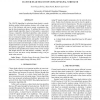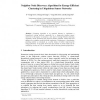110
click to vote
OPODIS
2010
14 years 10 months ago
2010
Abstract. Wireless Ad-hoc networks are distributed systems that often reside in error-prone environments. Self-stabilization lets the system recover autonomously from an arbitrary ...
119
click to vote
CORR
2010
Springer
15 years 24 days ago
2010
Springer
Clustering is a very popular network structuring technique which mainly addresses the issue of scalability in large scale Wireless Sensor Networks. Additionally, it has been shown...
121
Voted
CORR
2010
Springer
15 years 24 days ago
2010
Springer
-- In cluster-based routing protocol (CBRP), two-level hierarchical structure is successfully used to reduce over-flooding in wireless ad hoc networks. As it is vulnerable to a sin...
133
Voted
APNOMS
2006
Springer
15 years 4 months ago
2006
Springer
Setting up an IDS architecture on ad-hoc network is hard because it is not easy to find suitable locations to setup IDS's. One way is to divide the network into a set of clust...
108
Voted
CCECE
2009
IEEE
15 years 5 months ago
2009
IEEE
The LEACH algorithm for selecting cluster heads is a probabilistic method which produces clusters with a large variation of link distances and uneven energy consumption during the...
125
Voted
CIT
2004
Springer
15 years 6 months ago
2004
Springer
To solve the scalability issue of ad hoc network, a new cluster maintenance protocol is proposed. Clusters may change dynamically, reflecting the mobility of the underlying networ...
119
click to vote
EUC
2005
Springer
15 years 6 months ago
2005
Springer
Clustering algorithm is an essential element to implement a hierarchical routing protocol, especially for a large-scale wireless sensor network. In this paper, we propose a new typ...
101
Voted
IPCCC
2007
IEEE
15 years 7 months ago
2007
IEEE
LEACH (Low Energy Adaptive Clustering Hierarchy) [1] is one of the popular cluster-based structures, which has been widely proposed in wireless sensor networks. LEACH uses a TDMA ...
96
Voted
ICC
2007
IEEE
15 years 7 months ago
2007
IEEE
—In this paper, we study the node clustering problem in UnderWater Sensor Networks (UWSNs). We formulate the problem into a cluster-centric cost-based optimization problem with a...
112
click to vote
SUTC
2008
IEEE
15 years 7 months ago
2008
IEEE
With the availability of low-cost sensor nodes there have been many standards developed to integrate and network these nodes to form a reliable network allowing many different typ...




